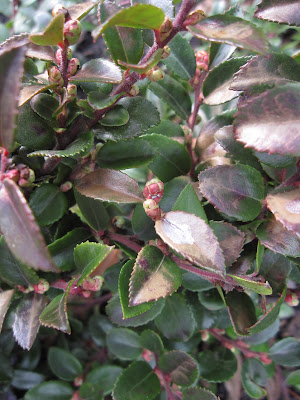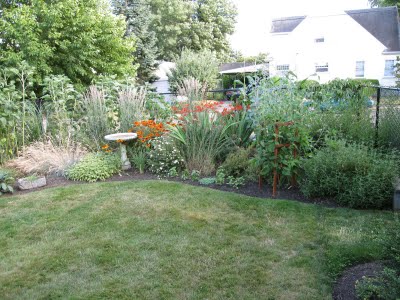The next best thing to planting in your own garden is planting in someone else's.
Yesterday, the MulchMaid joined over 80 people in the Overlook and Arbor Lodge neighborhoods to plant street and yard trees with Friends of Trees. We planted over 85 trees in Overlook alone. Here in the Pacific Northwest, late winter is one of the best times to plant trees so they benefit from spring rains while they are first settling in.
Friends of Trees has got it down to a science. First, they get all the trees that people have ordered and bring them to a central location.
Even leafless, trussed for travel, or bare-root, the young trees look beautiful.
Then teams with an FOT-trained team leader and an assistant take their assigned trees to the homes to plant them.
Here are my team's trees. We planted a cascara sagrada, a Jonagold apple, an asian pear, two hawthornes, a strawberry tree (Arbutus unedo) and three Douglas firs. We had three of the tree's homeowners on our team.
Generally, the tree holes are dug ahead of time. Team leaders demonstrate proper planting techniques and make sure the homeowners know how to care for their new trees.
I only managed a few pictures of the actual tree-planting process because everything was so wet - this is Portland, people - and it was pretty muddy. In fact, you could tell the veteran tree planters by their rain pants: my jeans got very muddy! At least I remembered to bring my insulated work gloves.
Above, our team has just finished planting a shapely young hawthorne tree in the parking strip of the happy homeowners in the center of the group. They couldn't believe the price: just $14.99.
So if it's too early or too wet to work in your own garden, I recommend getting your planting fix (and meeting some new gardening friends) by joining a Friends of Trees event. Check it out - there are still lots of plantings left to go this winter and spring.
Yesterday, the MulchMaid joined over 80 people in the Overlook and Arbor Lodge neighborhoods to plant street and yard trees with Friends of Trees. We planted over 85 trees in Overlook alone. Here in the Pacific Northwest, late winter is one of the best times to plant trees so they benefit from spring rains while they are first settling in.
Friends of Trees has got it down to a science. First, they get all the trees that people have ordered and bring them to a central location.
Even leafless, trussed for travel, or bare-root, the young trees look beautiful.
Then teams with an FOT-trained team leader and an assistant take their assigned trees to the homes to plant them.
Here are my team's trees. We planted a cascara sagrada, a Jonagold apple, an asian pear, two hawthornes, a strawberry tree (Arbutus unedo) and three Douglas firs. We had three of the tree's homeowners on our team.
Generally, the tree holes are dug ahead of time. Team leaders demonstrate proper planting techniques and make sure the homeowners know how to care for their new trees.
I only managed a few pictures of the actual tree-planting process because everything was so wet - this is Portland, people - and it was pretty muddy. In fact, you could tell the veteran tree planters by their rain pants: my jeans got very muddy! At least I remembered to bring my insulated work gloves.
Above, our team has just finished planting a shapely young hawthorne tree in the parking strip of the happy homeowners in the center of the group. They couldn't believe the price: just $14.99.
So if it's too early or too wet to work in your own garden, I recommend getting your planting fix (and meeting some new gardening friends) by joining a Friends of Trees event. Check it out - there are still lots of plantings left to go this winter and spring.














































